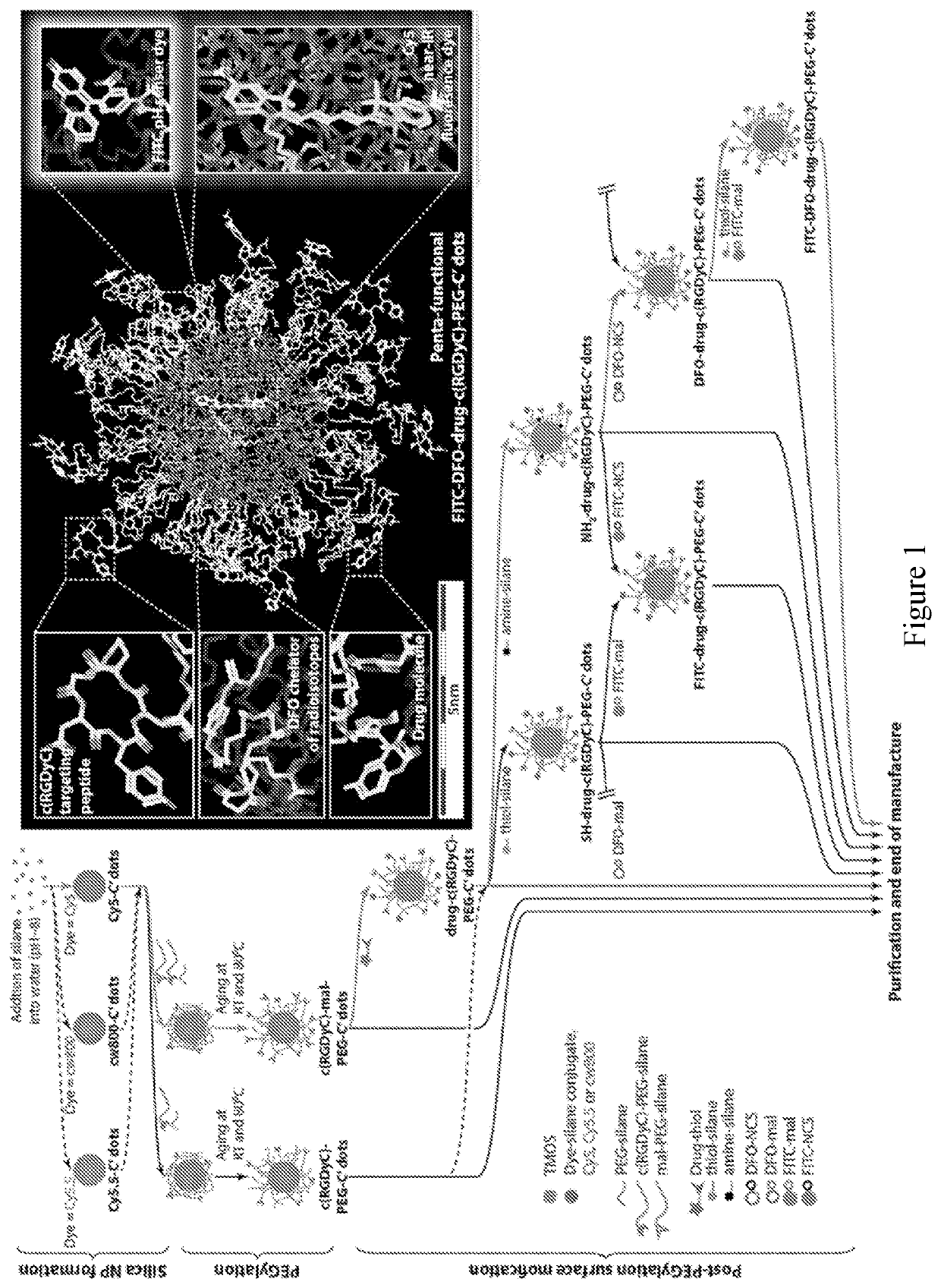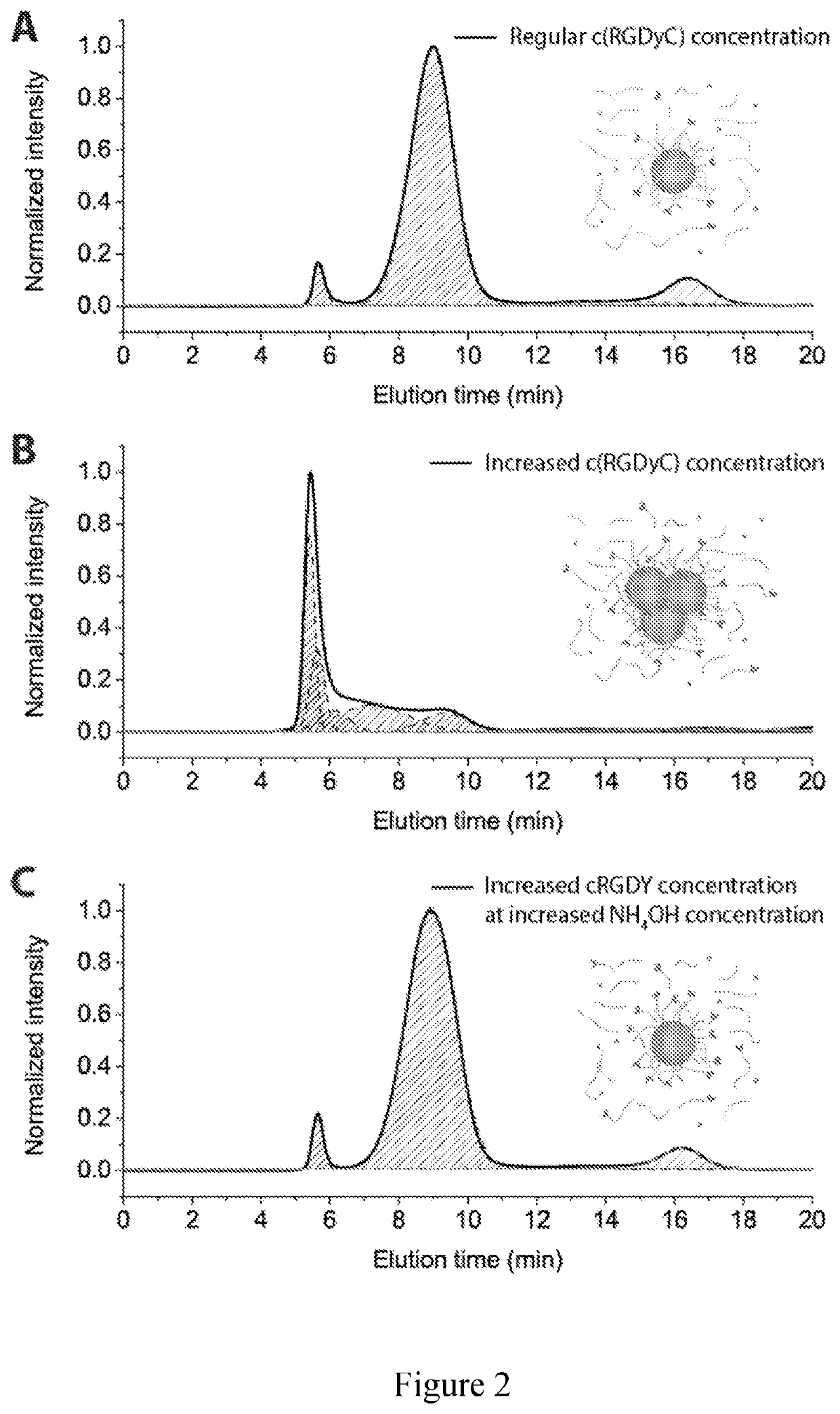Functionalized nanoparticles and methods of making and using same
a technology of functionalized nanoparticles and nanoparticles, which is applied in the direction of inorganic non-active ingredients, microcapsules, capsule delivery, etc., can solve the problems of exposing these tissues to toxic elements, particle sizes of 10 nm and below are at the limit of size control of this synthesis process, and the peg can be tricky
- Summary
- Abstract
- Description
- Claims
- Application Information
AI Technical Summary
Benefits of technology
Problems solved by technology
Method used
Image
Examples
example 1
[0104]This example provides examples of methods and compositions of the present disclosure and uses of same.
[0105]Multifunctional nanoparticles (NPs) combining different functional components into a single NP platform are of great interest in the fields of nanobiotechnology and nanomedicine. In this example, we describe a versatile surface modification approach to modularly and orthogonally functionalize Cornell prime dots (C′ dots), ultrasmall sub-10 nm PEGylated fluorescent core-shell silica nanoparticles, with up to four types of different functional ligands on the NP surface. It enables the synthesis of penta-functional C′ dots integrating a variety of properties into a single NP, i.e. fluorescence detection, specific cell targeting, radioisotope chelating / labeling, ratiometric pH sensing, and drug delivery, while the overall NP size remains below 7 nm. This is achieved by taking advantage of the fact that the PEG layer of C′ dots is penetrable to small molecules. Amine- and / or ...
example 2
[0148]This example provides examples of methods and compositions of the present disclosure and uses of same.
[0149]Described is an example of functional C′ dots synthesized via PPSMI approach, i.e. DBCO-PEG-Cy5-C′ dots, is described (FIG. 18). The DBCO-PEG-Cy5-C′ dots contain DBCO reactive groups between the PEG chains on C′ dot surface. The DBCO groups can further react with azide-conjugated functional ligands via click chemistry to introduce additional functional groups to C′ dots. To produce DBCO-PEG-Cy5-C′ dots, silane-conjugated Cy5 fluorescent dye was first covalently encapsulated in the silica nanoparticles during the formation of C′ dot silica cores. PEG-silane was then covalently attached to the surface of the silica nanoparticles, forming PEGylated PEG-Cy5-C′ dots. After the PEGylation step, amine-silane was added into the reaction mixture to covalently attach to the remaining silanol groups under the PEG layer of C′ dots via silane condensation, introducing reactive amine ...
example 3
[0150]This example provides examples of methods and compositions of the present disclosure and uses of same.
[0151]Described is an example of functional C′ dots synthesized via PPSMI approach, i.e. DBCO-DFO-PEG-Cy5-C′ dots, is described (FIG. 19). The DBCO-DFO-PEG-Cy5-C′ dots contain both DBCO reactive groups and DFO chelator groups between the PEG chains on C′ dot surface. While the DBCO groups can further react with azide-conjugated functional ligands via click chemistry to introduce additional functional groups to C′ dots, the DFO groups can chelate radio-metals to enable C′ dots to be used as positron emission tomography (PET) probes. To produce DBCO-DFO-PEG-Cy5-C′ dots, silane-conjugated Cy5 fluorescent dye was first covalently encapsulated in the silica nanoparticle during the formation of C′ dot silica cores. PEG-silane was then covalently attached to the surface of the silica nanoparticles, forming PEGylated PEG-Cy5-C′ dots. After the PEGylation step, amine-silane was added i...
PUM
| Property | Measurement | Unit |
|---|---|---|
| size | aaaaa | aaaaa |
| size | aaaaa | aaaaa |
| size | aaaaa | aaaaa |
Abstract
Description
Claims
Application Information
 Login to View More
Login to View More - R&D
- Intellectual Property
- Life Sciences
- Materials
- Tech Scout
- Unparalleled Data Quality
- Higher Quality Content
- 60% Fewer Hallucinations
Browse by: Latest US Patents, China's latest patents, Technical Efficacy Thesaurus, Application Domain, Technology Topic, Popular Technical Reports.
© 2025 PatSnap. All rights reserved.Legal|Privacy policy|Modern Slavery Act Transparency Statement|Sitemap|About US| Contact US: help@patsnap.com



